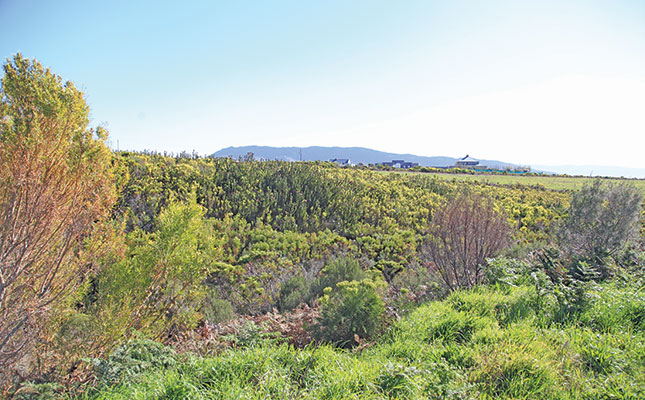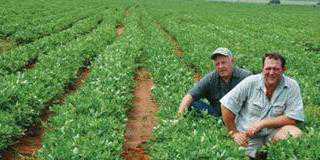
Photo: Glenneis Kriel
While farmers generally see themselves as custodians of the land, the conservation of
indigenous plant species is not always high on their list of priorities. This is understandable,
as most farmers already struggle to make ends meet.
But urbanisation, changes in land use, agricultural expansion and climate change
threaten the future of many species and habitats, and, ultimately, human existence.
According to an Intergovernmental Science-Policy Platform on Biodiversity and Ecosystem Services (IPBES) report released in May, approximately 85% of wetlands worldwide have been lost since the 1970s, and about 25% of species in assessed animal and plant groups are under threat. This suggests that about one million species will face extinction within decades.
Plants used as food also in decline
The assessment, compiled by 145 experts from 50 countries over the past three years, found that local varieties and domesticated plants were also disappearing fast, with at least 559 of the 6 190 varieties used for food production reported extinct in 2016 and 1 000 more now under threat.
While the value of crop production has increased almost threefold and raw timber
production by 45% since the 1970s, land degradation has seen a 23% reduction in productivity.
At the same time, a loss in pollinator diversity is threatening the sustainability of annual crops valued at up to US$577 billion (about R8,8 trillion).
Despite this, competition for land for conservation and agricultural production is expected to rise as population growth continues to drive higher food demand.
South Africa is one of the greatest biodiversity hotspots in the world, and the Greater Cape
Floristic Region is of particular interest. This comprises the Core Cape Subregion, dominated by fynbos, and home to more than 9 500 species, of which almost 70% are endemic, and the Extra Cape Subregion (the western Karoo), which has over 3 700 species, of which 40% are endemic.
The floral biodiversity in mountainous areas in the country is relatively intact compared
with the lowlands, which are more accessible for development, according to Rupert Koopman, a botanist from Cape Nature.
Areas previously considered of low agricultural potential are now coming under greater
threat, however, due to improved technologies and the relative scarcity of arable land.
Many South African farmers are aware of this threat. In 1998, for example, the South African wine industry established the world’s first sustainable production programme, the
Integrated Production of Wine (IPW) scheme, long before such measures were demanded by the market.
Farmers who participate in the scheme are entitled to carry a seal of approval on their wine labels confirming that they use environmentally responsible production practices and look after the biodiversity of their farms by maintaining indigenous forest and land.
‘Plant blindness’
Koopman explains that many farmers overlook the importance of biodiversity due
to ‘plant blindness’: they fail to distinguish between the various species that grow naturally
on their land. In addition to this, they are unaware of the status of the plants that occur naturally on their farms.
“In the Western Cape, there are more than 350 species where the total population [of
each species] occurs in an area of less than 10km²,” he says.
Some species are astonishingly limited in their range. According to the South African National Biodiversity Institute’s Redlist (redlist.sanbi.org), Agathosma orbicularis grows only in a small area in the Caledon/Swartberg area, with one sub-population found on a 0,1ha road reserve.
“Our smallest flowered protea, Protea odorata, has only three plants left on a site currently in the process of being formally conserved,” says Koopman.
Biodiversity and crop production
Farmers continually look for ways to remain financially viable, and often strive to produce more for less. Across the world, many have become increasingly aware of the value of biodiversity to their production.
This started with the use of crop rotation to break disease cycles in the 1970s, and now the benefits of cover crops are becoming more appreciated.
Farmers following regenerative agriculture principles, for example, aim to get at least eight different crops in their cover crop mixtures.
Organic and permaculture farmers have for years understood the value of leaving strips of indigenious vegetation near their production areas. In this way, harmful pests have a more natural feeding alternative to the crops.
The strips also offer a safe haven for beneficial predator insects that help keep pests under control.
Having healthy patches of natural land also increases the resilience of the farm in general. For example, the soil in well-managed indigenous patches is more efficient at ensuring water infiltration than the compacted soil of croplands; this enables the water table to recover faster after droughts.
Conversely, during floods, the soil in natural areas also acts as a sponge that helps regulate runoff.
Proven in studies
Research by Frederick Noack, Marie-Catherine Riekhof and Salvatore Di Falco of the University of British Columbia in Canada, published in September 2018, found that the drought resilience of natural soil also helped increase the resilience of rural communities.
Using data from 7 556 households in 23 developing countries, the researchers found that communities were able to use forest extraction to offset the negative affect of droughts during growing seasons. In this way, they turned biodiversity into an effective insurance against drought and other weather-related shocks.
It was also found that the negative impact of droughts on rural incomes declined with increasing levels of biodiversity.
Here in South Africa, Rhoda Malgas, a researcher at the Department of Conservation, Ecology and Entomology at Stellenbosch University, came to the same conclusion in her study of the value of wild rooibos in natural veld.
“Each plant species plays a role in the ecosystem, so its removal has knock-on effects on other plant and animal species in the system,” she explains.
“Rooibos and honeybush, for example, are important nutrient cyclers through their ability to fix nitrogen in low-nutrient soils. They make this nitrogen available for other plants in their community too. The greater the variety, the more resilient the system.”
Malgas found that small-scale rooibos farmers in the Northern Cape were able to sustain their income from wild harvesting, even while suffering major production losses due to the drought.
“Farmers [these days] base most of their production decisions on what the market demands,” says Malgas.
“I foresee that rising environmental pressures will change this in sectors which depend on fynbos, so that they will become more guided by what is available and grows naturally on their farms.”
Biodiversity is also important for the survival of commercial crop species. Malgas points out that commercial agriculture has resulted in farmers becoming increasingly dependent on a handful of cultivars, depending on what they are producing.
She stresses that as large a pool of tree and plant species as possible should therefore be preserved to ensure a wide selection of genes if existing commercial varieties lose their appeal or productivity.
“Many of the natural varieties are better adapted to climatic extremes or diseases than some of the commercial varieties, so their genes might be required to develop new varieties to ensure technological progress,” she explains.
Working together
Preserving biodiversity is done most effectively when farmers work together, stresses Koopman.
“Look at what landscape-level planning and projects through partners such as LandCare are doing in your region, and participate in these efforts to ensure you’re not wasting any money,” he suggests.
“Alien clearing without a plan can create greater problems than if you’d done nothing.”
He adds that yet another advantage of natural veld is that it usually increases the appeal of a farm, which in turn can open up new avenues for income generation through tourism activities, ranging from farm stays to hiking routes.
It is clear that investment in nature can pay off in more than one way.
Email Rupert Koopman at [email protected], or Rhoda Malgas at [email protected]. Read a summary of the assessment at ipbes.net.












